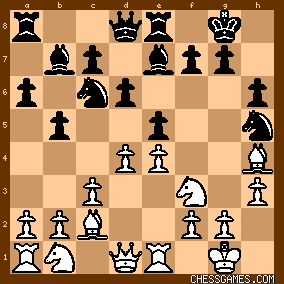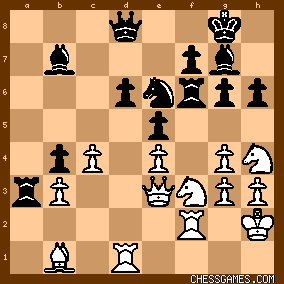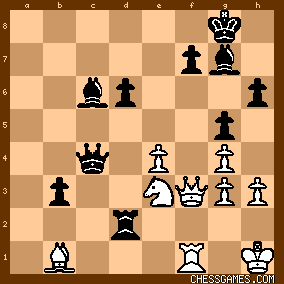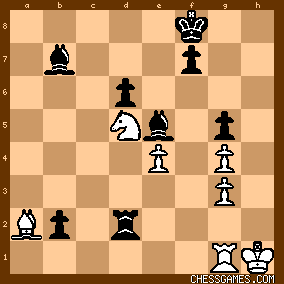Aug-23-08
 | | keypusher: Part I
This fine game is very entertainingly annotated in the Carlsbad 1907 tournament book (Brandreth 2007), with notes by Marco and additional comments by the modern editor, Robert Sherwood. Notes in plain text below are from Marco, notes in brackets are by Sherwood (with initials RHS) or me/Shredder. 1. e4 e5 2. Nf3 Nc6 3. Bb5 a6 4. Ba4 Nf6 5. 0-0 Be7 6. Re1 This is the most enduring mode of attack against 5....Be7. Black's position remains cramped for a long time and he is condemned to passivity. If he should fail to take the initiative at the right moment, if he should emerge too early or too late from his restraint, every possibility of defense disappears and every counter-move that Black tries has incidentally the same chance of success as the floundering of a fish in a net. Very instructive in this regard is the game Schlechter vs Von Bardeleben, 1904. 6....d6 7. c3 0-0 8. h3 b5 9. Bc2
Most masters play first Bb3, to entice the c6-knight to the edge of the board, and only after ...Na5 withdraw the bishop to c2. 9....Bb7 <Because of White's 9th move, Black could play ...d5 here.> 10. d4 Re8 11. Bg5 <Marco and Sherwood don't comment, but this doesn't look good to me.> 11....h6 12. Bh4 Nh5!
The first step towards freeing his game. If White exchanges on e7, not only does the black Queen become mobile but the knight on h5 becomes a sinister force, as it threatens to take up residence on f4. 
click for larger view |
|
Aug-23-08
 | | keypusher: Part II
13. Bg3
Many players would play this <prima vista> without straining and exhausting their brains with any further brooding. Certainly this is the most practical point of view, for one can never know what further terrors the future holds. It is therefore of immense importance surely to go easy on the brain and to enter into combinational play only after one's opponent has become completely numb as a result of his own brooding -- therefore in the fifth, sixth hour. Through the purposeful application of this method one can often turn the most powerful opponent into an infant. A two-move trap in the sixth hour is often more effective than a ten-move combination in the second hour. Hence the rule: If a bloodthirsty, violent opponent seeks to make combinations, always play the simplest move, requiring the least deliberation. Wait until the enemy has spent his gunpowder; then, as he is running away, you can strike him with an ordinary walking stick. The annotator unfortunately cannot make use of this trick, as he has no opponent to outfox, but instead must penetrate to the truth of the position. In the previous diagram, therefore, he must take into consideration the question (which always faces us when a knight is about to move or has moved from f6 to h5) of whether White might not get the advantage by a leap of his f3-knight. The following variations are worthy of note: I. 13. Bxe7 Qxe7 14. Nxe5 dxe5
i. 15. Qxh5 exd4. All of Black's troops are clearly in the fray, while White's knight on b1 and rook on a1 are still asleep. Hence this position is certainly undesirable for White. ii. 15. d5 Nf4 16. dxc6 Bxc6. This position is still more unpleasant for White than sub-variation i. II. 13. Nxe5 Bxh4! 14. Nxc6 Qf6!! with a winning attack. Only now are we convinced that Schlechter's 12....Nh5 was deeply thought out, and that Johner had in fact nothing better than the text move. <Sherwood again doesn't say anything, but surely 13. Bxe7 is better than 13. Bg3.> 13....Nxg3 14. fxg3 Bf6

click for larger view |
|
Aug-23-08
 | | keypusher: Part III
15. d5
This move is always double-edged, even when it seems so inviting. White must always be prepared for the advances ...c7-c6 and ...f7-f5, which destroy his center or are at least able to make it waver. But in the diagrammed position above White had no choice, for his d-pawn in under triple attack and his own knight on b1 would have remained encumbered for a long time. 15....Ne7 16. Nbd2 c6
One might think this move dubious, for the d6-pawn remains backward. But White cannot prevent ...d6-d5 without allowing all sorts of weaknesses. 17. dxc6 Bxc6 18. Qe2 Qb6+ 19. Kh2 g6
This is in preparation for an eventual ...f7-f5, eliminating the e4-pawn and thereby rehabilitating the pawn on d6. White must counteract this plan in time, otherwise the e5-pawn will become passed and the bishop pair will become ferocious. 
click for larger view20. c4! Bg7 21. Rad1 Rad8 22. b3 Bb7 23. g4
White has maneuvered superbly, preventing both ...d6-d5 and ...f7-f5 for the duration. <True enough, but he has also left himself with dark-square weaknesses that Schlechter gradually exploits. To a large extent the fact that White's alternatives are so unpleasant can be blamed on 13. Bg3.> 23....Nc6 24. Bd3 b4 25. Nf1 Nd4 26. Qf2 Re6
Black hopes by this move to dissuade White from the good plan Ne3-d5, and he succeeds. White sees 27. Ne3 Rf6 28. Nd5 Bxd5 29. cxd5 Nxf3+ 30. gxf3 Qxf2+ and is naturally dismayed. But instead of 28. Nd5 he could first play 28. Rd2, protecting his queen and at the same time preparing Nd5, with satisfactory prospects. 27. Nh4?
Misplacing the knight and ruining his position for no apparent reason. 27....Rf6 28. Qe3
The first evil consequence of 27. Nh4. The most natural continuation, Ne3-d5, White himself has rendered impossible. His knight on f1, which could take part in the battle advantageously instead now sits idle, and Black gains time for decisive operations. 28....a5!
The open a-file assumes for Black a decisive importance. 29. Rd2 Ra8 30. Rf2 Qd8 31. Nd2 Rf4 32. Ndf3 a4 33. Ref1(?) <White doesn't have to throw a pawn away like this. 33. g3 axb3! 34. axb3 Rf6 35. Nxd4 exd4 36. Qd2 Rxf2+ 37. Qxf2 Ra3 and, though Black is better, White is still in the game. (Shredder).> |
|
Aug-23-08
 | | keypusher: Part IV
33...axb3 34. axb3
Of course not 34. Nxd4 exd4 35. Qxf4 on account of 35....Be5. <Incidentally, as far as the history of chess strategy goes Black's knight on d4, allowing Nxd4 exd4 with doubled center pawns, is noteworthy. Of another game in which Black allowed doubled pawns on d6 and d4, Kotov vs Petrosian, 1953, Bronstein wrote: <We should like to draw the reader's attention to the d4-pawn in this game: doubled, isolated, and surrounded by enemy pieces, still it showed an exceptional vitality. Such pawns were nonexistent in the games of Morphy, Steinitz, Lasker, Capablanca or Alekhine: they made their debut in contemporary grandmaster games, further enriching the treasury of ideas.> Well, he didn't mention Schlechter....>> 34....Ne6
34....Nxb3 was a very good move. 34....Ne6, threatening ...Nc5, looks better still. <Shredder strongly prefers ...Nxb3.> 35. g3 Rf6 36. Bb1 Ra3
37. Rd1
Preventing ...Nc5.
<37. Ng2 Nc5 38. Bc2 (threatening Nxe5) followed by Neg1 offers better chances of holding the game. (RHS)> 
click for larger view37....Nd4!
Excellent, since now the black b-pawn becomes irresistible. 38. Nxd4
<A blunder. More stubborn is 38. Bc2 Ra2 39. Rdd2, when Black must show how he can get into White's position. (RHS)> 38....exd4 39. Qxd4 Rxf2+ 40. Qxf2 Rxb3 41. Ng2
Black threatened 41....Rb2.
|
|
Aug-23-08
 | | keypusher: Part V
41.....Rb2 43. Qf3 Qe7

click for larger viewVery disconcerting for White, who must now ask himself whether 43....Rxb1 44. Rxb1 Bxe4 45. Qe2 Bxb1 46. Qxe7 b3 would not be immediately fatal for him; for example, 47. Ne3 Bc2 48. Nxc2 bxc2 49. Qe1 Bb2 and wins. 44. Bd3
The variations pointed out in the previous note appeared sufficiently suspect that it seemed advisable to prevent the exchange sacrifice ...Rxb1. But readers who do not have to suffer under the pressure of a time limit will certainly have discerned that 43....Rxb1 44. Rxb1 Bxe4 45. Qe2 Bxb1 would be deleterious for Black. White can proceed, after 47. Qxe7 b3, with 47. Qe8+ and can force the win with 47....Kh7 48. Qxf7 b2 49. Nf4!. The threat ...Rxb1 was therefore not yet at the acute stage, but it was hanging in the air, and Johner rightly wanted to bring this chronic condition to an end. 44....Qe6 45. Rf1 b3 45. Qf4 Bc6 46. Kh1 g5 47. Qf3 Rd2 Threatening 48....Rxd3 49. Qxd3 Qxe4!, when the b-pawn advances without hindrance. 48. Bb1 Qxc4 49. Qe3

click for larger view49....Qe2!
Annihilating! After 50. Qxf7+ Kh8! White would have to resign at once. 50. Qxe2 Rxe2 51. Nd5 Kf8 52. Rc1 Bb7 53. h4 Be5 54. hxg5 hxg5 55. Rg1 Rb2 56. Bd3 Rd2 57. Bc4 b2 58. Ba2 
click for larger view58....Ba6! White resigns
There is nothing to be done against the threats ...Bd3 and ...Be2. |
|
| Jan-05-12 | | Gypsy: <keypusher> Thx for the great work! |
|
|
|
|





